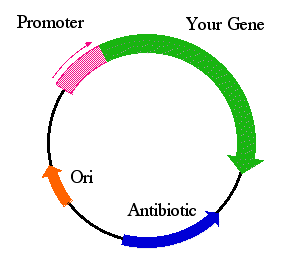
Many times, an investigator wants to produce the protein encoded by a piece of cloned DNA. For this purpose, expression plasmids or vectors have been constructed (figure 1). To express the protein, the plasmid must be placed inside a cell (prokaryote or eukaryote). Once inside the cell, the promoter will attract the RNA polymerase and lead to the production of an mRNA. The cell's ribosomes will translate the RNA into a protein. This allows investigators to produce large amounts of the protein, produce an epitope tagged protein, or produce a range of protein concentrations if the promoter can be regulated.

Figure 1. Map of a generic expression vector. This simplistic example contains an inducible promoter (red), your favorite gene (green), a gene that confers antibiotic resistance (blue), and an origin of replication (orange) used to produce many copies of the plasmid.
A very popular way to regulate the amount and the timing of protein expression is to use an inducible promoter. An inducible promoter is not always active the way constitutive promoters are (e.g. viral promoters). Some inducible promoters are activated by physical means such as the heat shock promoter. Others are activated by chemical such as IPTG or Tetracycline (Tet).
IPTG is a classic example of a compound added to cells to activate a promoter. It is often used to activate the lacZ gene when cloning a new fragment of DNA and using blue/white selection. IPTG can be added to the cells to activate the downstream gene or removed to inactivate the gene.
Tetracycline, the antibiotic, has be used to create two beneficial enhancements to inducible promoters. One enhancement is an inducible on or off promoter. The investigators can choose to have the promoter always activated until Tet is added or always inactivated until Tet is added. This is the Tet on/off promoter. The second enhancement is the ability to regulate the strength of the promoter. The more Tet added, the stronger the effect so now you can turn up or down an expression vector the way you turn up or down the volume on a radio.
© Copyright 2002 Department of Biology, Davidson College, Davidson, NC 28036
Send comments, questions, and suggestions to: macampbell@davidson.edu